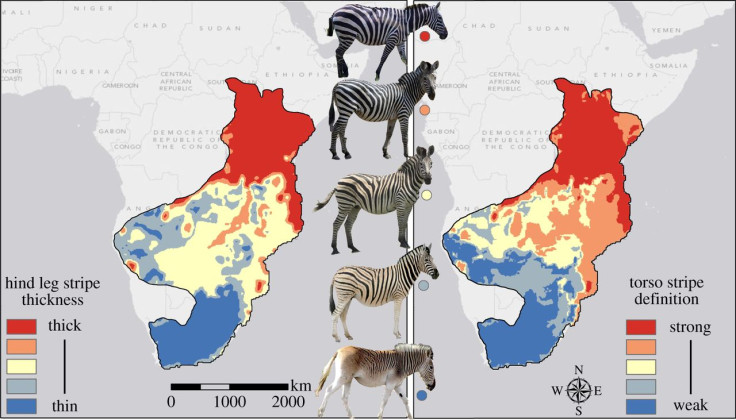How the zebra really got his stripes: To stay cool in savannah heat

The question of why zebras have stripes has plagued scientists for eons, with no one answer explaining their unique black and white pattern.
Theories put forward include social cohesion, thermoregulation, the avoidance of biting flies and to evade predators – but none have provided a clear adaptive evidence as to why they have stripes.
A study published in the Royal Society's Open Science has now looked at the biological and environmental factors to test each of these explanations.
Brenda Larison, from University of California, Los Angeles, and colleagues, wrote: "Plains zebra striping pattern varies regionally, from heavy black and white striping over the entire body in some areas to reduced stripe coverage with thinner and lighter stripes in others.
"We examined how well 29 environmental variables predict the variation in stripe characteristics of plains zebra across their range in Africa."
The changes in colouration of zebras from different areas suggests the adaptation to local environments, the study said.
"In this paper we put the predation, thermoregulation and biting fly hypotheses to a spatially explicit empirical test by modelling how variation in plains zebra stripe pattern is associated with variation in environmental variables."
The study said that computer simulations suggest strong black and white patterns make it difficult for predators to capture their prey. This would mean that a stronger pattern is observed where encounters with more lions (zebra predators) is likely.

With flies, research has shown that stripes prevent two species of biting insects from landing on surfaces, but this explanation does not account for other biting flies. Another explanation is that the stripes either break up the zebra silhouette or create an optical illusion.
If this is the case, the scientists say stripe characteristics on the legs and stomach will correlate with fly prevalence.
Thirdly, researchers suggest stripes help zebras with thermoregulation – the idea that the black and white stripes heat up differently causing an airflow between the two, producing a cooling effect.
"This mechanism should work most effectively on strong, contrasting stripes, so we would predict good coverage with bold black and white striping to occur in areas in which zebra are regularly exposed to higher temperatures."
Findings showed that temperature was the most significant predictor of zebra stripe patterns across Africa, supported by the vast variation that was explained by the models, including stripe thickness and definition.
"Our study has shown a strong correlation between temperature and striping across the plains zebras' range. The relationship between temperature and stripe pattern is clear and, along with the lack of genetic structuring among populations, suggests an adaptive explanative for stripe variation.
"In contrast to recent findings, we found no evidence that striping may have evolved to escape predators or avoid biting flies."
Speaking to IBTimes UK, Larison said that temperature control is one of a number of "important functions" of zebra stripes. She also said she believes predation and biting flies could still play a role in their development.
"Temperature seems to be the main factor associated with the degree of striping. We found thicker, bolder black and white stripes where temperatures are consistently warm (tropical regions) and thinner, paler, incomplete stripes where temperature fluxuates and drops to low temperatures during some times of the years."
Discussing if the riddle of the zebra stripes will ever be answered, she added: "We believe it is solvable and we are continuing to work it."
© Copyright IBTimes 2025. All rights reserved.






















